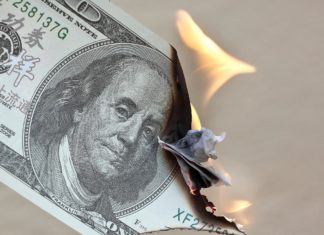GDP Growth Rate As Such Will Not Make Economy Stronger.
 Mikhail Eskindarov,
Mikhail Eskindarov,
Rector of the Financial University under the Government of the Russian Federation, Doctor of Economic Sciences
 Dmitry Sorokin,
Dmitry Sorokin,
Corresponding Member of the Russian Academy of Sciences, Research Supervisor of the Financial University under the Government of the Russian Federation
DECEITFUL GROWTH RATE FIGURES
Reports on whether the GDP of a particular country has changed over the last month, and by how many tenths of a percent, invariably make the headlines of economic news. Estimates and forecasts of the dynamics of this indicator are an obligatory part of speeches delivered by economic authorities, both foreign and domestic, and experts. At the same time, it is implied that it is precisely the high rates of GDP growth and its size that directly determine the upsurge in the country’s economic power and the arrival of the overall prosperity for its population.
We have repeatedly heard over the last two years that Russia’s GDP in its decline is about to reach the “bottom”, we considered as a victory its decline by 0.2% over the last year instead of the originally projected 0.6%, and we expect and hope that it will grow by either 0.6% or even as much as 1.5% this year. Various groups of experts have prepared proposals for the government on how to accelerate GDP growth to a level higher than the world’s average (some promise this after 2019, others in 2 years, and the most radical of them say next year). But is everything so straightforward?
During the period 2000-2008 the average annual increase in the Russian GDP was about 7% per year, twice the world’s average. This made it possible not only to restore its volume lost during the economic catastrophe of the 1990s, but also to surpass its pre- crisis level by almost 18%. Real disposable incomes of the population (cash incomes less mandatory payments, adjusted for consumer price growth) grew as well, and by 2008 exceeded the pre-crisis level by 16%. But this is the average figure.
And what was, for example, the case with those 29% of the population whose income in 2000 was below the “poverty line” (the subsistence minimum determined by the price of the minimum consumer basket). According to statistical data, the share of such population decreased to about 13% by 2008. It would seem like a good dynamics. But we must bear in mind that in 2000 the subsistence minimum was about half the average per capita monetary income, and in 2008 — about a third. But the share of the population that has less than half the average per capita income remained the year 2000 level, 29%. Given that the prices for housing and utilities, which you cannot avoid paying, increased 11 times, for pre-school education services more than 6 times, for education more than 4 times and for medical services almost 5 times, it is clear how to answer the question: did those who by 2008, as in 2000, earned no more than half the average per capita income cease to be poor not in statistical sense but in real life? In general, consumer prices for goods which are acquired by the lowest-income group of population increased 3.5 times, while the prices for goods purchased by the highest-income group increased 2.9 times. As a result, if the excess of the average monetary incomes of 10% of the highest-income population over 10% of the lowest- income population (we note that the super-rich and homeless people are not included in this account) was 13.9 times in 2000, in 2008 it was up to 16.6 times. This means that the rich took advantage of the GDP growth to a greater extent than the poor.
If we assume that GDP growth automatically brings us closer to universal happiness, then how can we explain the fact that in the period 2000-2008 the natural decline in the population (the difference between the born and the deceased) turned out to be over a million people more than during the previous 8 years of economic catastrophe, and the country’s population decreased by 3.6 million compared to 2.3 million in the previous eight years? Finally, how to explain that the 18% excess over the pre-crisis GDP level occurred when the production rate in industry and agriculture turned out to be approximately 15% lower by 2008 than in 1991, particularly 17% lower in processing industries, and 8% lower in the construction industry?
READ YOUR TEXTBOOK
Нappened in France
Despite the high growth rates of the world’s economy measured by changes in GDP, and the overly optimistic forecasts based on those measurements, a massive financial and economic crisis arrived “unexpectedly”.
To answer these questions, let us recall how the GDP is determined. This indicator was proposed in 1934 by the economist Simon Kuznets, a Russian migr , who received the Nobel Prize in economics in 1971 for «an empirically substantiated interpretation of economic growth, which led to a new, deeper understanding of economic and social structures and the development process». It may sound too coarse to a professional statistician but, keeping aside the subtleties of the calculation, in the mundane sense it is the sum of the prices of all products produced and services rendered over a certain period of time consumed domestically and sold abroad. A separate problem is the accounting of products and services produced in the informal sector of the economy and those that cannot be expressed in monetary terms (for example, you repaired a car by yourself). To ensure the comparability of the GDP in different years, its value is adjusted taking into account the price changes in the periods being compared (GDP in comparable prices).
How was the high rate of GDP growth achieved in 2000-2008? The Ministry of Economic Development, both at that time and later, correctly noted that at least half of the GDP growth was attributable to high growth rates of oil and gas export revenues. Later, the decline in GDP in 2009 and the subsequent slowdown in its growth that turned into a decline in 2015 — 2016 was explained by a decrease in those revenues. Now the hopes for a higher rate of GDP growth are again connected with the expectations that the oil export price will be $50 per barrel, and not $40 as predicted.
All this is written in order for the reader (non-economist) to understand: the magnitude of GDP, the rate of its growth, and even the volume of GDP per capita show important things, especially the dynamics of the country’s economic activity. Of course, these values to some extent reflect the magnitude of real national wealth and actual well-being of citizens. But only to a certain extent, indirectly, if you will. So, when the GDP fell by 7.8% in 2009, the real disposable monetary incomes of the population not only did not decrease but even grew by 3% thanks to the measures taken by the government. At the same time, in 2011, when the GDP growth was 4.3%, real monetary incomes increased by a mere 0.5%. In the current crisis, with a 2.8% decline in GDP in 2015, real cash incomes fell 3.2%, while in 2016, a mere 0.2% decline in the GDP instantly resulted in almost 6% slump in those incomes. Neither the rate of GDP growth nor its absolute magnitude will say anything about exactly what products and services were produced, how they were distributed and used, or, in general, how much better life has become from financial, cultural or safety perspective for the country’s population as a whole and the social groups that make up the population, and what the further prospects in this area are. In order to answer this question, it is necessary to know what makes up the GDP, the technological structure of production and the composition of the products and services produced, the situation with employment, working conditions and labor content, how the incomes and property of the population are distributed, the country’s ecological situation and the state of its natural resources, etc., etc.
GDP GIVES NO REALISTIC DESCRIPTION OF THE ECONOMY
In early 2008, at the initiative of the then President of France, John Stiglitz and Amartya Sen, Nobel Prize- winning economists, and Professor Jean-Paul Fitoussi led the establishment of the Commission on the Measurement of Economic Performance and Social Progress that was joined by many well-known economists working on both sides of the Atlantic. The establishment of the Commission was due to the fact that despite the high growth rates of the world’s economy measured by changes in GDP, and the overly optimistic forecasts based on those measurements, a massive financial and economic crisis arrived “unexpectedly”. The report made an unambiguous conclusion that the fetishization of GDP and the dependence of the economic policy on its growth did not yield a realistic picture of the state of the economy and, therefore, not only would not lead the society to welfare but also threatened to have negative effects on its future. As a matter of fact, the “inventor” of the GDP indicator Kuznets warned about this, repeatedly pointing out the fallacy of identifying the growth of GDP with the growth of economic and social welfare.
It seems that the current authors of forecasts, plans, and programs for the country’s economic growth should focus on the ultimate goals, the attaining of which will mean a steady growth in the country’s and its citizens’ welfare. These goals include maintaining high life expectancy, ensuring decent working conditions and labor content that allow for an increase in the production of competitive goods, solving the housing problem, gaining access to education and expanding access to cultural values, overcoming excessive poverty and income differentiation, preserving and improving the state of the natural environment, bio— and natural resources and, of course, ensuring safety in the broadest sense. Having determined the parameters of these goals (the list of which is incomplete by far), based on the available resources, it will be possible to determine the stages (timeframe) of their accomplishment and to mull over the corresponding economic and organizational measures (mechanisms) ensuring movement in the right direction. Expressed in price terms, this movement will determine the GDP dynamics. With a different approach, when the growth of GDP is at the forefront, the need for certain actions and their order of priority will be determined not by how they affect the well-being of the society, but, above all, by the contribution they make to the increase in the GDP growth rate. Thus, we often hear that investments in education and science have a big effect on GDP growth. But it is not out of place to ask: when will this effect manifest itself? In a year? In two? It is clear that the return on these investments, expressed in GDP growth, will be obtained in the longer term. But if the immediate increase in GDP is all that matters, the expenditures for these purposes will look like a deduction from always limited resources, and will therefore be inevitably subjected to reduction (sequestration). The exactly same approach can be seen in the latest (November, 2016) forecast until 2019 by the Ministry of Economic Development, in which the increase in the GDP growth rate to the world average level (the so-called target option) “implies restraint in the growth of consumption and social spending during the early years of the forecast period”. Perhaps it will happen this way. But what will happen next, beyond 2019? There’s nothing new in being asked to “tighten belts” for the sake of high growth rates. We know how it ended the last time — with the collapse of the Soviet economy.
In general, a simple recipe can be proposed to accelerate GDP growth. Let the conscientious wives of the party members in both chambers of the Federal Assembly, government and municipal officials and all those, including economic observers, who by their duty or inner conviction identify the growth of GDP with the arrival of universal happiness, immediately register themselves as individual entrepreneurs to provide household services. First, it will be immediately possible to report a rapid growth of the number of small businesses. Secondly, conscientious husbands will now not only give their wives their salaries and other incomes, but also pay them for the same household services that the wives usually provide in the family (a price-current, or, as it is now customary to say, a price list for any of these services can be found online). Need I say how the country’s GDP will immediately skyrocket? True, no more borscht will be produced in the country. But this is not so important, if the problem of GDP growth will be solved.
The book New Industrial Society by John Kenneth Galbraith, the author who is widely known and respected in the world economic community, was published 50 years ago. In this book he wrote, among other things, that for those who are busy shaping economic policy the gross (volumetric) value indicators (at that time they were the national income and the gross national product) are “the sole measure of social success. This is the modern criterion of good and evil. It is assumed that St. Peter asks everyone who knocks at the gates of paradise only one question: what have you done to increase the gross national product?” Does the growth of economic literacy in the past few years consist only in replacing the word “national” with “domestic” in the question of St. Peter?
Of course, making the GDP grow at a rate that is higher than the world average is a vital necessity for our country. However, if this gain results from higher prices for our commodity exports, increased output of obsolete products, actions that undermine the prospects for the country’s sustainable development, etc., then — no matter what the statistics shows — this will have a negative impact on the country. We need to make the GDP grow by increasing the competitiveness of the economy and the well-being of citizens, by overcoming the excessive social and economic differentiation among different groups of population and regions, and by doing everything that leads to an increase in the number of happy people who are proud of their country.



































